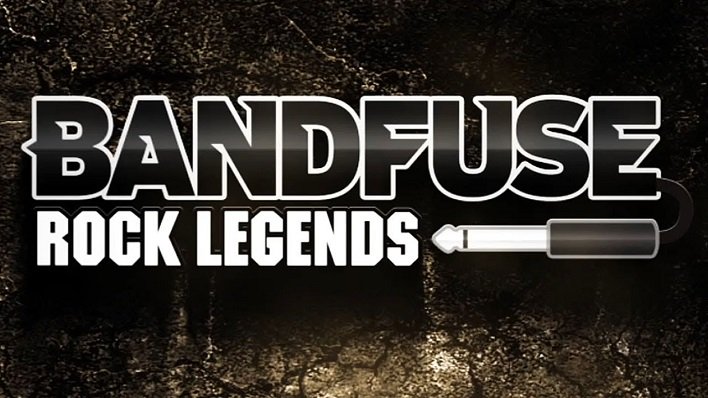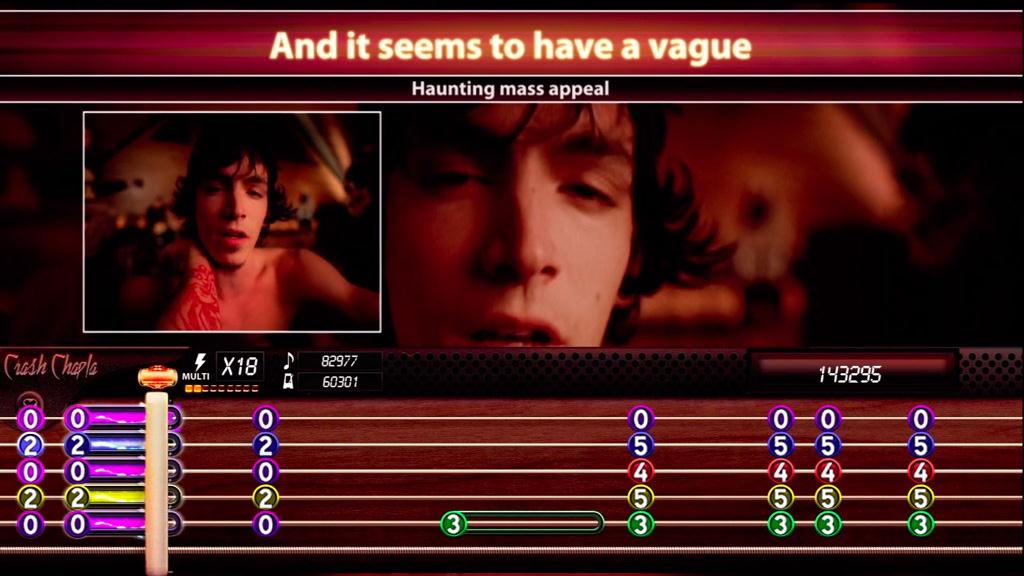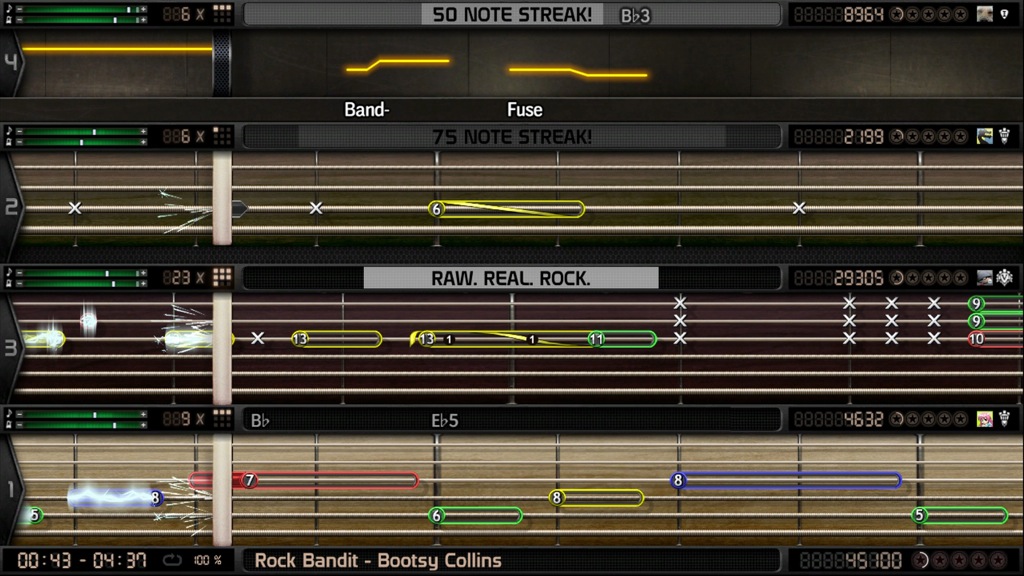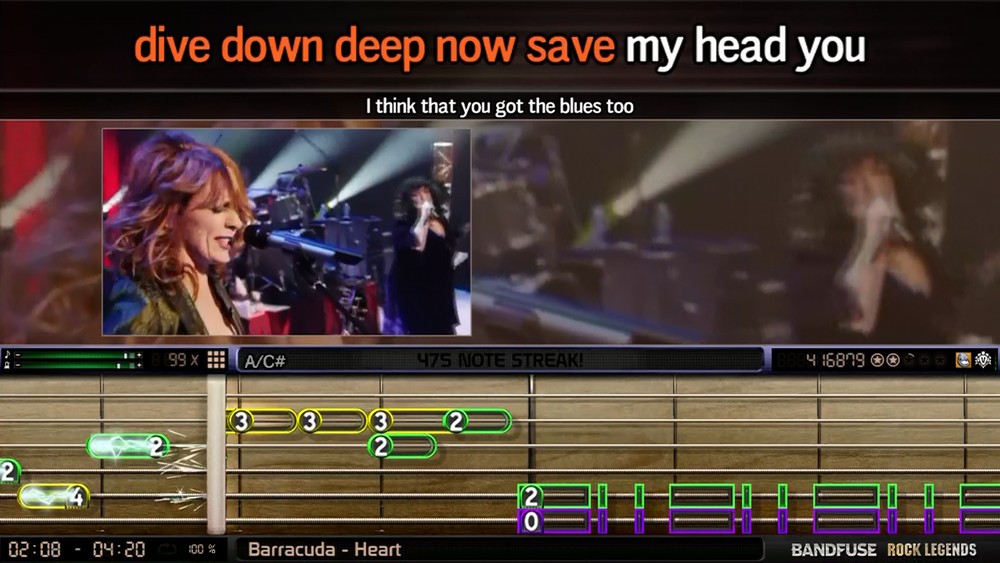Bandfuse: Rock Legends Review

Core gameplay is functional, superb song list, great sound design
Not geared for beginners, poor lessons, boring visual design, clustered layout makes it difficult to differentiate different notes and techniques in-game, layout even more clustered in multiplayer, grading system a little too harsh
Bandfuse has some good ideas and, for the most part, functions properly, but poor design choices, lazy training for fledgling musicians, and a harsh grading system sap all the fun from the game. It doesn't feel like much love or passion went into making this game and overall feels like a cheap cash-in which is something that instantly ruins anything that focuses on music because music is a passion.
If Bandfuse was released before Rocksmith, then the game would be revolutionary, but sadly that is not the case. Like the epic battle between Guitar Hero and Rockband, Rocksmith needs a rival band and Bandfuse just isn't it.
No Encore for This Game
Gone are the days of music/rhythm games which use fake, plastic instruments, and in with games that allows people to play with real instruments. Thanks to the revolutionary Rocksmith series, the music genre has not only been given life once again, but has also evolved. By setting the example on how it’s done, it was only a matter of time before another developer would take a stab at this gameplay style, but alas, Bandfuse‘s inefficient and somewhat lazy design keeps it from being a worthy competitor to Rocksmith.
Gameplay
Learning to play an instrument isn’t necessarily an easy task to undertake and is something not everyone will be able to do; this is why an educational tool in the form of a video game is a good idea. Unfortunately for newcomers and novices, Bandfuse is mostly a video game that uses real instruments whereas Rocksmith balanced musical education and gameplay fairly evenly.
There are lessons in Bandfuse, but they are somewhat useless videos featuring various, famous guitarists like Slash with no hands-on exercises. Having an established musician give away a few tips isn’t a bad idea, but the execution is off by quite a bit. Also some lessons seemed to be out of place such as how to be a producer which, in my opinion, is something a person should go to school for instead of relying on a $60 game if he/she wishes to walk down that career path.
Aside from the half-assed lessons and its distaste towards rookies, Bandfuse‘s core gameplay works and the instruments, or microphone, can be heard loud and clear; too bad the rest of the game doesn’t hold up too well.
Unlike Rocksmith‘s 3D, vertical tablature, Bandfuse uses a more traditional horizontal tablature much like the kind used in sheet music or computer music programs like Guitar Pro. The game also color-codes the notes to represent which finger should be used for each particular note. Both of these ideas sound great on paper, but don’t transition very well in-game.
The area in which notes fly across the screen is narrow which makes it very difficult to read the notes accurately. Too make this worse, the technique symbols are hard to distinguish because of this, I never once managed to recognize a hammer-on or pull-off, and some of the symbols, like regular notes and palm mutes, are just a little too similar. Mix this with each note having different colors and you’ve got yourself both a headache and blood-shot eyes.
Granted, this may not have been a problem if the note area was larger, but why is it so small in the first place?  The answer: so the song’s music video can be seen clearly, that’s why. The focus should be on the connection between music and the player, not the poorly-made, 80s music video.
Another problem with the game is the harsh grading system which makes Guitar Hero 3‘s grading system look like Mother Teresa. Players can get the score multiplier up to 99, but this doesn’t guarantee a five-star rating because timing and pitch are factored into the score. I like the idea of the game rating my timing as it means I can see where I am making a mistake and improve, but the game never really points out my mistakes and just hands out a score.
For those that don’t know, pitch is determined by string type, length, tension, and how the player plucks the string which makes me wonder why it is part of the grading system. Pitch is also determined by which fret is being used so apparently playing the wrong note counts as a double infraction where not playing anything counts as one.
A reason for this problem could be because the tuner may not function properly. Players can tune every string individually, but the final test requires the player to strum all strings at once, with the exception of the bass, to determine if everything is in order. I’m not sure if it’s due to hardware sensitivity or the function is inaccurate, but after tuning each individual string to perfection, according to the tool, the final test determined that every string was far off from the correct tune.
When playing music, the gamer has one of two options: tour or quickplay. Playing the tour mode is like playing an alpha build of the original Guitar Hero, not in gameplay but in career design. Players pick a song, or group of songs, play through them and receive money to unlock new venues which is weird because the venues are abstract.
Unlike Guitar Hero, the difficulty is unbalanced as even the beginner tour contains intermediate level songs. Due to the lack of showmanship, structure, and uneven difficulty, players will probably have more fun just playing whatever song they want in quickplay and avoid the dull career mode.
This is the one area Bandfuse does quite well, the song list. Bolstering a truly great set of songs though, I feel most are geared more towards intermediate players and up. I love that Dream Theater finally made it back into a music game, and the awesome “Pull Me Under” no less, and that “Cult of Personality” gets some recognition once again.
Bandfuse also contains an amplifier mode and allows players to play with backing tracks, though the modes are extremely barebones with limited features; once again, Rocksmith 2014 did it better. Still, a guitar game without an amp function wouldn’t be much of a guitar game at all.
Graphics & Sound
Not much can be said for the graphics as the game contains mostly dark backgrounds, brightly colored symbols, and music videos. Had there have been less contrast, perhaps the tablature would be easier to watch, but overall, the game isn’t pretty.
On the other hand, the game sounds great. The music from both the audio tracks and the instruments can be heard loudly and clearly. The great song list and sturdy sound design are Bandfuse‘s greatest strengths.
Multiplayer
Bandfuse allows up to four people to play together; one on lead guitar, rhythm, bass, and vocals. Once again, this sounds great on paper, but the narrow, horizontal pathways only get narrower with more people. Rockband worked because it used three vertical pathways and one horizontal for vocals making it easier for everyone to see what needs to be done, but Bandfuse‘s doesn’t because it is too clustered. On the bright side, there are no music videos present with four player co-op.
SpawnFirst Recommends…
 Bandfuse has some good ideas and, for the most part, functions properly, but poor design choices, lazy training for fledgling musicians, and a harsh grading system sap all the fun from the game. It doesn’t feel like much love or passion went into making this game and overall feels like a cheap cash-in which is something that instantly ruins anything that focuses on music because music is a passion.
Bandfuse has some good ideas and, for the most part, functions properly, but poor design choices, lazy training for fledgling musicians, and a harsh grading system sap all the fun from the game. It doesn’t feel like much love or passion went into making this game and overall feels like a cheap cash-in which is something that instantly ruins anything that focuses on music because music is a passion.
If Bandfuse was released before Rocksmith, then the game would be revolutionary, but sadly that’s not the case. Like the epic battle between Guitar Hero and Rockband, Rocksmith needs a rival band and Bandfuse just isn’t it.












